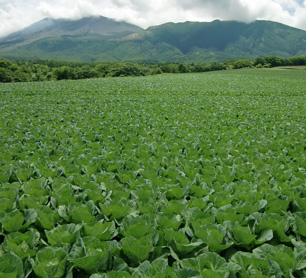Alachlor (Lasso®)
| EPA Maximum Contaminant Level (MCL) |
0.002 mg/L |

Alachlor is used in on brassica crops, like this row of cabbages nestled at the foot of Mt. Asamayama.
Alachlor (also known by many trade names, notably Lasso® and Bullet®) is an organic chemical used as an herbicide to control grasses and broadleaf weeds in corn and other row crops, including cotton, brassicas (cabbages, broccoli, cauliflower, Brussel sprouts, mustard seed), oilseed rape, peanuts, radishes, soy beans, and sugar-cane. Its use is restricted in the United States, but it was at one time one of the most highly used herbicides in the U.S.
It can arrive in drinking water through agricultural runoff.
Health Effects of Alachlor
Alachlor is a likely carcinogen with a wide range of harmful health effects on the liver, kidneys, spleen, eyes and blood. According to the EPA:
Some people who drink water containing alachlor well in excess of the maximum contaminant level (MCL) for many years could have problems with their eyes, liver, kidneys, or spleen, or experience anemia, and may have increased risk of getting cancer.
Water Treatment for Alachlor
The EPA recommends granular activated carbon (GAC) for the treatment of alachlor.
Sources:EPA, WHO, EXTOXNET, Farm Chemicals International, Photo: WikiMedia, author: On Chan
Site Index
Filtration Systems
- Aeration for Iron & Sulfide
- Backwashing Filters
(whole house & well units)
- Chlorine & Chemical Injectors
- Countertop Water Filters
- Emergency Filters
- Garden Hose Filters
- Reverse Osmosis, Residential
- Reverse Osmosis, Commercial
- Shower Filters
- Specialty Filters
- Ultraviolet Systems
- Undersink Filters
- Water Softeners
- Whole House Filters
Cartridges
Parts
- Replacement Parts
- Faucets
- Filter Media
- Fittings
- Housings
- O-rings
- Pumps
- Pura UV
- R.O. Parts
- R.O. Tanks
- R.O. Booster Pump
- VIQUA UV